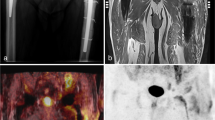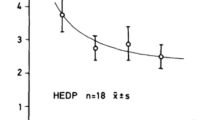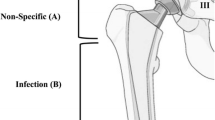Abstract
Introduction
The most frequent complications of total hip arthroplasty are septic and aseptic wear-induced loosening. A reliable differentiation between septic and aseptic loosening with current diagnostic tools is not possible. Therefore, we examined the diagnostic valency of positron emission tomography (PET) with 18F-fluorodeoxyglucose (FDG) in cases of septic or aseptic hip arthroplasty loosening compared with conventional triple-phase bone scan (TPBS).
Materials and methods
Fifty patients with 70 total hip replacements (symptomatic n=50, asymptomatic n=20) were examined by means of FDG-PET and TPBS to detect septic and aseptic loosening and differentiate between the two. A differentiated algorithm subdivided into categories I–V was developed for FDG-PET. Additionally, standardized uptake values (SUV) were calculated from the lesion with the highest FDG uptake. Interpretations of the TPBS were done according to the criteria described by Wilson. The final diagnosis was based on operative findings including microbiological and histological examinations (n=50), while the remaining asymptomatic arthroplasties (n=20) were integrated into a clinical follow-up (≥9 months).
Results
Sensitivity/specificity of FDG-PET was 91%/92% (accuracy 91%) compared with 78%/70% (accuracy 74%) for TPBS. A high correlation could be proved between FDG-PET investigation and operative histopathological findings (rSpear≥0.9). No significant differences were found regarding cemented and uncemented implanted hip arthroplasties (p≥0.05). Calculation of the SUV turned out to be inappropriate as a sole criterion for image interpretation.
Conclusion
FDG-PET is a promising, highly accurate examination method to detect polyethylene and metal wear-induced chronic inflammation followed by periprosthetic osteolysis. In addition, FDG-PET has a significantly higher sensitivity and specificity than TPBS for differentiating between aseptic loosening and infection.



Similar content being viewed by others
References
Bax JJ, Patton JA, Poldermans D, Elhendy A, Sandler MP (2000) 18-Fluorodeoxyglucose imaging with positron emission tomography and single photon emission computed tomography: cardiac applications. Semin Nucl Med 30:281–298
Chacko TK, Zhuang H, Stevenson K, Moussavian B, Alavi A (2002) The importance of the location of fluorodeoxyglucose uptake in periprosthetic infection in painful hip prostheses. Nucl Med Commun 23:851–855
Coleman RE (1998) Clinical PET in oncology: clinical positron imaging 1:15–30
De Winter F, Wiele C van de, Vandenberghe S (2001) Coincidence camera FDG imaging for the diagnosis of chronic orthopedic infections: a feasibility study. J Comput Assist Tomogr 25:184–189
De Winter F, Wiele C van de, Vogelaers D, Desmet K, Verdonk R, Dierckx RA (2000) FDG-PET as a single technique is more accurate than the combination of bone scan and white blood cell scan in chronic orthopaedic infections. J Nucl Med Suppl 15
Engh CA, Massin P, Suthers KE (1990) Roentgenographic assessment of the biologic fixation of porous-surfaced femoral components. Clin Orthop 257:107–128
Erdman WA, Tamburro F, Jayson HAT, Weatherall PT, Ferry KB, Peshock RM (1991) Osteomyelitis: characteristics and pitfalls of diagnosis with MR imaging. Radiology 180:533–539
Friedebold G, Wolff R (1987) Klinische Ergebnisse zementloser Hüftprothesen. Med Welt 38:1386–1389
Garellick G, Malchau H, Herberts P (2000) Survival of hip replacements. A comparison of a randomized trial and a registry. Clin Orthop 375:157–167
Guhlmann A, Brecht-Krauss G, Suger G, Glatting G, Kotzerke J, Kinzl L, Reseke SW (1998) Fluorine-18-FDG PET and technetium-99m antigranulocyte antibody scintigraphy in chronic osteomyelitis. J Nucl Med 39:2145–2152
Herberts P, Malchau H (2000) Long-term registration has improved the quality of hip replacement: a review of hip replacement of the Swedish THR Register comparing 160,000 cases. Acta Orthop Scand 71:111–121
Itasaka T, Kawai A, Sato T, Mitani S, Inoue H (2001) Diagnosis of infection after total hip arthroplasty. J Orthop Sci 6:320–326
Kälicke T, Schmitz A, Risse JH, Arens S, Keller E, Hansis M, Schmitt O, Biersack HJ, Grünwald F (2000) Fluorine-18 fluorodeoxyglucose PET in infectious bone diseases: results of histiologically confirmed cases. Eur J Nucl Med 27:524–528
Kavanagh BF, Fitzgerald RH Jr (1985) Clinical and roentgenographic assessment of total hip arthroplasty. Clin Orthop 193:133–140
Kraemer WJ, Saplys R, Waddel JP, Morton J (1993) Bone scan, gallium scan, and hip aspiration in the diagnosis of infected total hip arthroplasty. J Arthroplasty 8:611–616
Kubota R, Yamada S, Kubota K, Ishiwata K, Tamahashi N, Ido T (1992) Intratumoral distribution of fluorine-18-fluorodeoxyglucose in vivo: high accumulation in macrophages and granulation tissues studied by microautoradiography. J Nucl Med 33:1972–1980
Levitsky KA, Hozack WJ, Balderston RA, Röhman RH, Gluckman SJ, Maslack MM, Booth RE Jr (1991) Evaluation of the painful prosthetic joint: relative value of bone scan, sedimentation rate, and joint aspiration. J Arthroplasty 6:237–244
Palestro CJ, Torres MA (1997) Radionuclide imaging in orthopedic infections. Semin Nucl Med 27:334–345
Palmer WE, Rosenthal DI, Schoenberg OI, Fischman AJ, Simon LS, Rubin RH, Polisson RP (1995) Quantification of inflammation in the wrist with gadolinium-enhanced MR imaging and PET with 2–18F-fluoro-2deoxy-D-glucose. Radiology 196:647–655
Peters AM (1998) The use of nuclear medicine in infections. Br J Radiol 71:252–261
Pfahler M, Schidlo C, Refior HJ (1998) Evaluation of imaging in loosening of hip arthroplasty in 326 consecutive cases. Arch Orthop Trauma Surg 117:205–207
Revell PA, Weightmann B, Freeman MAR, Roberts BV (1978) The production and biology of polyethylene wear debris. Arch Orthop Trauma Surg 91:167–181
Sammak B, Abd El Bagi M, Al Shahed M (1999) Osteomyelitis: a review of currently used imaging techniques. Eur Radiol 9:894–900
Schmitz A, Risse HJ, Kälicke T, Grünwald F, Schmitt O (2000) FDG-PET zur Diagnostik und Verlaufskontrolle entzündlicher Prozesse: Erste Ergebnisse aus orthopädischer Sicht. Z Orthop 138:407–412
Seabold JE, Nepola JV (1999) Imaging techniques for evaluation of postoperative orthopedic infections. Q J Nucl Med 43:21–28
Sugawara Y, Braun DK, Kison PV, Russo J, Zasadny K, Wahl R (1998) Rapid detection of human infections with fluorine-18 fluorodeoxyglucose and positron emission tomography: preliminary results. Eur J Nucl Med 25:1238–1243
Van Acker F, Nuyts J, Maes A, Vanguckenborne B, Stuyck J, Bellemans J, Vleugers St, Bormans G, Mortelmans L (2001) FDG-PET,99mTc-HMPAO white blood cell SPET and bone scintigraphy in the evaluation of painful knee arthroplasties. Eur J Nucl Med 28:1496–1504
Willert HG, Bretram H, Buchhorn GH (1990) Osteolysis in alloarthroplasty of the hip: the role of ultra-high molecular weight polyethylene wear particles. Clin Orthop 258:95–107
Wilson MA (1997) Musculoskeletal system. In: Wilson MA (ed) Textbook of nuclear medicine. Lippincott-Raven, Philadelphia, pp 3.32
Wirtz DC, Niethard FU (1997) Etiology, diagnosis and therapy of aseptic hip prosthesis loosening—a status assessment. Z Orthop 135:270–280
Yamada S, Kubota K, Kubota R, Ido T, Tamahashi N (1995) High accumulation of fluorine-18-fluorodeoxyglucose in turpentine-induced inflammatory tissue. J Nucl Med 36:1301–1306
Zhuang H, Chacko T, Hickeson M, Stevenson K, Feng G, Ponzo F, Garino JP, Alavi A (2002) Persistent non-specific FDG uptake on PET imaging following hip arthroplasty. Eur J Nucl Med 29:1328–1333
Zhuang H, Duarte P, Pourdehand M, Shnier D, Alavi A (2000) Exclusion of chronic osteomyelitis with F-18 fluorodeoxyglucose positron emission tomographic imaging. Clin Nucl Med 25:281–284
Zhuang H, Duarte PS, Pourdehand M, Maes A, Acker F van, Shnier D, Garino JP, Fitzgerald RH, Alavi A (2001) The promising role of 18-FDG PET in detecting infected lower limb prosthesis implants. J Nucl Med 42:44–48
Acknowledgement
The performed experiments described here comply with the current laws of Germany.
Author information
Authors and Affiliations
Corresponding author
Rights and permissions
About this article
Cite this article
Mumme, T., Reinartz, P., Alfer, J. et al. Diagnostic values of positron emission tomography versus triple-phase bone scan in hip arthroplasty loosening. Arch Orthop Trauma Surg 125, 322–329 (2005). https://doi.org/10.1007/s00402-005-0810-x
Received:
Published:
Issue Date:
DOI: https://doi.org/10.1007/s00402-005-0810-x




